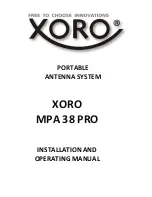
13
1.) Start with checking the mounting of the feed horn. All the legs on the tripod should be of the same length. You should
measure them, and do any adjustment you can if they are not the same length. Next you have to check the distance
from three different points on the edge of the dish, to the center of the feed horn. Remember, even if the tripod legs have
the same length, that does not mean the feed is centered! You might have to “bend” the feed back into center of the
dish.
2.) Set the off-set angle on your polar mount (declination). This is an adjustment that tilts the dish forward at an angle
of about 4-6 degrees, depending on what latitude you live. You can find the exact angle for your location in charts, but
if you set it for about 5 degrees, you’ll be close enough to get going. This adjustment is usually done on one of the
mounts connected directly to the dish.
3.) You then move the dish to the highest point on your polar mount. You do this by using the actuator. You can do this
by visually looking at the dish and the polar mount. You are basically centering the dish on the highest point on the polar
mount. Now you have to set the elevation angle of the dish. I like to use a meter for this, but it is also possible to do it
without. The elevation angle is about 40 degrees, depending on you latitude. This is not very critical at this point
because you will adjust the angle for best reception later. If you measure the angle on the mount, you might have to add
the declination angle to get the true dish pointing angle.
4.) You need to find a satellite that is located just south of your location. In most cases, there is a satellite close to the
longitude you live. A few degrees off will not make much difference because the dish moves almost flat in the center
of arc. Try a Ku band satellite because the accuracy is much higher. However, you night look for a C band satellite
when you start. It will be easier to find than a Ku band satellite. Having the dish parked at the highest point of the arc,
you have to turn the whole polar mount on the ground pole till you hit the satellite. If your elevation was way off, you
might not even get a signal. Adjust the elevation and turn the mount again until you find the satellite located straight
south.
5.) Fine tune the elevation angle. Turn the mount sideways until max signal and then adjust the elevation angle until its
maxed. At this point, you have set the off-set angle and the elevation angle for the satellite at the highest point in the arc.
6.) Now, you have to get the dish to track on the sides of the arc. This is where most people fail. Do not adjust any
elevation angles on the mount at this point. Move the dish using the actuator to a satellite on one side of your arc. You
should hopefully see the signal from the satellite, if not, pick a satellite closer to the center of the arc. Peak the dish on
the satellite using the actuator. Next, you have to push or pull upwards and downwards on the dish. You don’t have to
use much force, just a bit to see if the signal gets better or worse when you push/pull on the dish. What you are actually
doing is to change the elevation angle a bit. If your dish is pointing at a satellite to the east of center and you have to
push up on the dish to get a better signal, then the elevation angle must be adjusted higher. You adjust this by turning
the whole mount to the east. You have to use the actuator and move the dish a bit west to peak the signal. You go back
and forth until the dish has the correct elevation. Next, you have to check a satellite on the other side of the arc. If you
peaked the dish for center, and the for one side, the other side should be very close. This well depend on your ground
pole, offset angle/elevation angle and quality of feed/dish.
7.) If your dish is not hitting center on the other side, try the same adjustment as above. If the dish needs to be pushed
up to get a better signal, then turn the whole mount in that direction, If the dish needs to be pulled down for better signal,
then turn the mount the opposite direction ( towards the higher point on arc).
8.) Then, go back and check the other side. Hopefully, you’re not far off. You might have to go from side to side before
your dish tracks perfectly.
9.) If, and only if you can not get both sides to peak, both sides would be too low or too high. You can then do a small
adjustment of the declination (elevation) angle to get the two sides into peak. But only do this if you can confirm that both
sides are low or high. Increase the declination and the elevation angle the same amount. They will cancel each other
i the center of arc, but track lower on the sides.
10.) You should now have a perfectly peaked dish. If you used Ku band satellites for the peaking, it will be as good as
it can get, If you used C band satellites, you might want to do the same thing using Ku band satellites.
Mount Adjusting


































